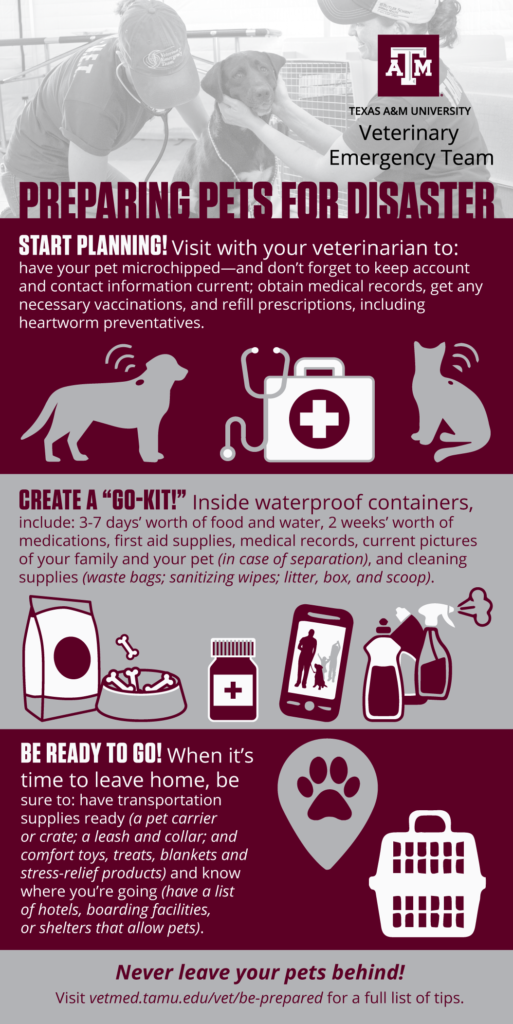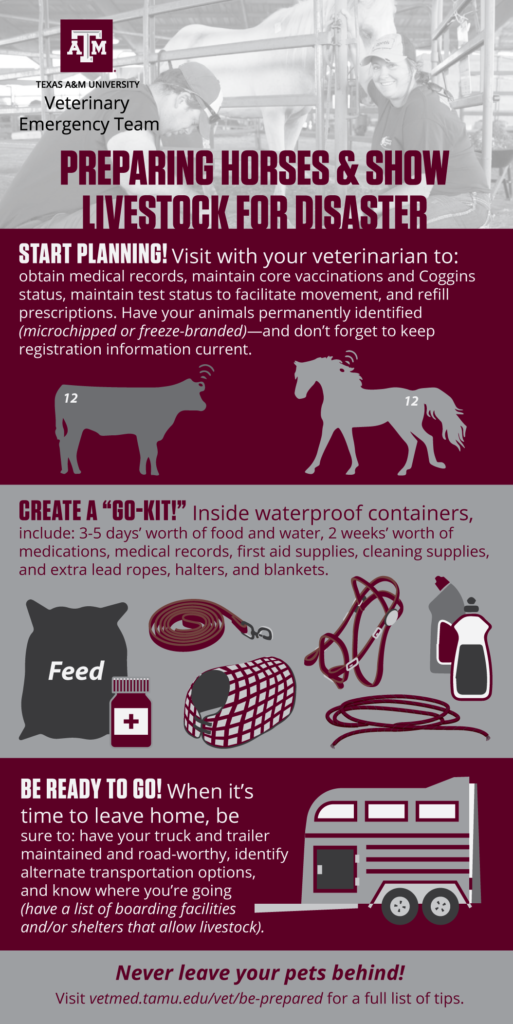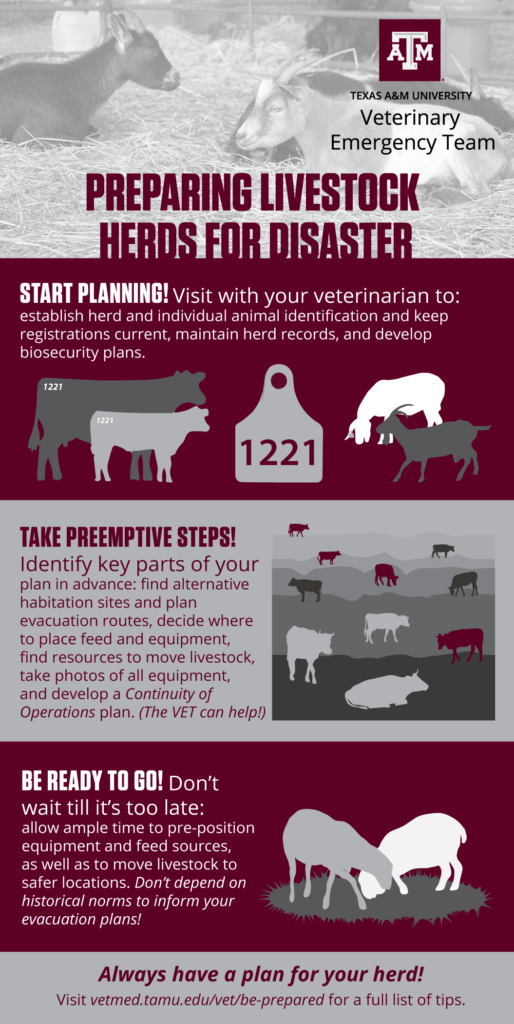Did you know?
Surveys indicate that more than 90 percent of pet owners are not prepared for the next natural disaster.
To help you prepare, the VET has some tips for establishing a plan in the event that you have to evacuate your home and animals during an emergency situation:
Remember! A disaster can strike at any time! Therefore, the VET encourages all families to be safe and prepared by planning for their furry family members as they plan for themselves.
Evacuating family pets

Before a disaster, call your veterinarian to begin your planning process—if your pet is not up-to-date on their vaccinations, schedule an appointment to do so. While you’re there, have your veterinarian:
- Give you a copy of your pet’s medical records, since some shelters may not accept pets that are not current on their vaccinations;
- Refill any prescriptions your pet may need; and
- Talk with you about planning for any specific needs your pet may have.
Create a pet disaster preparedness kit with items placed in waterproof bags or containers. Your kit might include:
- Basic survival items like three to seven days’ worth of food and water (Banfield has an online tool to help you determine how much of these items you’ll need, which can be found at bit.ly/banfieldnutrition), pet bowls, and two weeks’ worth of medications;
- First aid supplies;
- Cleaning supplies, including pet waste bags and sanitizing wipes;
- Your pet’s records, including rabies tags, medical records, and microchip number information;
- Pictures of you, your family, and your pet, in case of separation; and
- Feline supplies, including a litter box, scooper, and litter.
Don’t forget transportation supplies—a pet carrier or crate, a leash and collar, and familiar items such as toys, treats, blankets or bedding, and/or stress-relief products (pheromone sprays or wipes) will help you move your pet safely and comfortably.
Ensure your pet is microchipped—Banfield also found that more than half of those surveyed do not have their pet microchipped. In addition to ensuring your pet is always wearing up-to-date identification tags, talk with your veterinarian about microchipping your pets—and ensure your account and contact information is kept current—to increase the likelihood of a reunion if your pet gets loose amidst chaos.
Know where you’re going—prepare for a possible evacuation by compiling a list of hotels, boarding facilities, or shelters that will allow you to bring your pets; include contact information and addresses for each.
In the event of a natural disaster, never leave your pets behind in vehicles, tethered, or crated without you or a member of your family. Pets left outdoors are at risk for diseases—in the event of heavy rains and flooding, mosquitoes multiply, increasing the likelihood of the spread of heartworm disease to your pet, so ensure your pet is on year-round heartworm preventive medicine—as well as storm-related injuries, and, possibly, death.
Stay informed!
- Organizations like the Banfield Foundation offer online resources to help you prepare your family and pet for an emergency.
- Local emergency management offices may also have details about your area’s evacuation and sheltering plans.
- A current list of contacts, including your veterinarian, emergency veterinarians in an area to which you are likely to evacuate, and an animal control office, in the event that your pet may be lost or injured.
Evacuating horses & show livestock

Before a disaster, visit with your veterinarian—if your horses are not up-to-date on their vaccinations, schedule an appointment to do so. While you’re there:
- Develop a vaccination strategy and maintain core vaccination status (to facilitate movement);
- Maintain your horse’s current Coggins status;
- Obtain your animal’s medical records;
- Obtain a two-week supply of necessary pharmaceuticals.
- Talk about planning for any specific needs your animal may have.
Create a “Go-Kit”—with items placed in waterproof bags or containers. Your kit might include:
- Coggins papers;
- Vaccination records;
- A medical record summary;
- Cleaning supplies;
- A two-week supply of medication;
- A three-to-five-day food and water supply; and
- Extra lead ropes and halters.
Ensure your horse has can be identified with a form of permanent ID—such as a microchip or freeze brand and make sure chips and brands are appropriately registered.
When the time comes, be prepared to evacuate.
- Have a truck and trailer appropriately maintained and road-worthy
- Identify alternative transportation options
- Make sure your horse is trained to load
- Know where you’re going—have a list of destinations, including where in your county horses may be sheltered or found, in the event that your horse is rescued.
Stay informed!
- Local emergency management offices may also have details about your area’s evacuation and sheltering plans.
- A current list of contacts, including your veterinarian, emergency veterinarians in an area to which you are likely to evacuate, and an animal control office, in the event that your pet may be lost or injured.
Managing livestock herds

Before a disaster, visit with your veterinarian to:
- Maintain herd records
- Develop biosecurity plans designed to protect your herd
- Establish herd and individual animal ID plans
Take pre-emptive steps:
- Identify alternative habitation sites to evacuate your cattle;
- Identify routes to evacuation sites;
- Identify sites to pre-position equipment and feed supplies;
- Pre-identify resources that will be available for moving livestock
- Take photos of all equipment
- Develop a Continuity of Operations Plan (CoOP)—the VET can help!
Ensure your herd has can be identified with a form of permanent ID—either through individual animal IDs or a herd identification. And make sure holder brands are registered with the appropriate authorities.
Consider creating a POC (persons to contact) list—with names, telephone numbers, e-mails of those who might need to be contacted at any stage of evacuation and relocation
- Include those who might be receiving/accepting livestock and those who might need to provide any authorization for further movement or livestock care during the period that livestock is being held at the temporary location.
- That contact list would be available for distribution in volume, either electronically or in paper handouts when/where appropriate.
Develop a formal written formal timeline—that gives deliberate thought in advance to the readiness steps/preparation requirements. This helps remove the natural tendency to hesitate until the last minute to start the movement of your herd or complete all that needs to be done before a disaster.
When the time comes, be prepared to evacuate.
- Don’t wait until the last minute—allow ample time to pre-position equipment and feed sources and move livestock to a safer location.
- Don’t depend on historical norms.
Stay informed!
- Local emergency management offices may also have details about your area’s evacuation and sheltering plans.
- A current list of contacts, including your veterinarian, emergency veterinarians in an area to which you are likely to evacuate, and an animal control office, in the event that your pet may be lost or injured.
